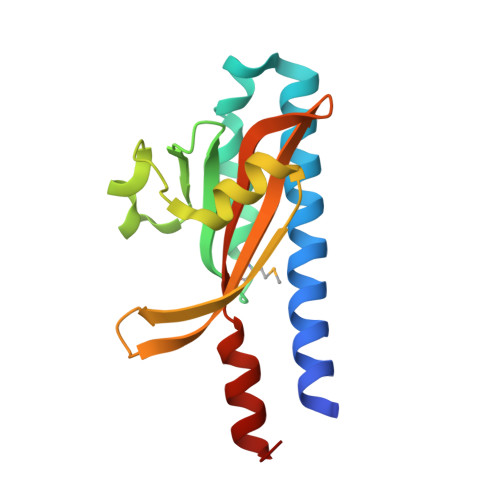Structure and mechanism of the essential two-component signal-transduction system WalKR in Staphylococcus aureus.
Ji, Q., Chen, P.J., Qin, G., Deng, X., Hao, Z., Wawrzak, Z., Yeo, W.S., Quang, J.W., Cho, H., Luo, G.Z., Weng, X., You, Q., Luan, C.H., Yang, X., Bae, T., Yu, K., Jiang, H., He, C.(2016) Nat Commun 7: 11000-11000
- PubMed: 26987594
- DOI: https://doi.org/10.1038/ncomms11000
- Primary Citation of Related Structures:
4YWZ - PubMed Abstract:
Most low GC Gram-positive bacteria possess an essential walKR two-component system (TCS) for signal transduction involved in regulating cell wall homoeostasis. Despite the well-established intracellular regulatory mechanism, the role of this TCS in extracellular signal recognition and factors that modulate the activity of this TCS remain largely unknown. Here we identify the extracellular receptor of the kinase 'WalK' (erWalK) as a key hub for bridging extracellular signal input and intracellular kinase activity modulation in Staphylococcus aureus. Characterization of the crystal structure of erWalK revealed a canonical Per-Arnt-Sim (PAS) domain for signal sensing. Single amino-acid mutation of potential signal-transduction residues resulted in severely impaired function of WalKR. A small molecule derived from structure-based virtual screening against erWalK is capable of selectively activating the walKR TCS. The molecular level characterization of erWalK will not only facilitate exploration of natural signal(s) but also provide a template for rational design of erWalK inhibitors.
- Department of Chemistry, Department of Biochemistry and Molecular Biology, and Institute for Biophysical Dynamics, Howard Hughes Medical Institute, The University of Chicago, 929 East 57th Street, Chicago, Illinois 60637, USA.
Organizational Affiliation:

















